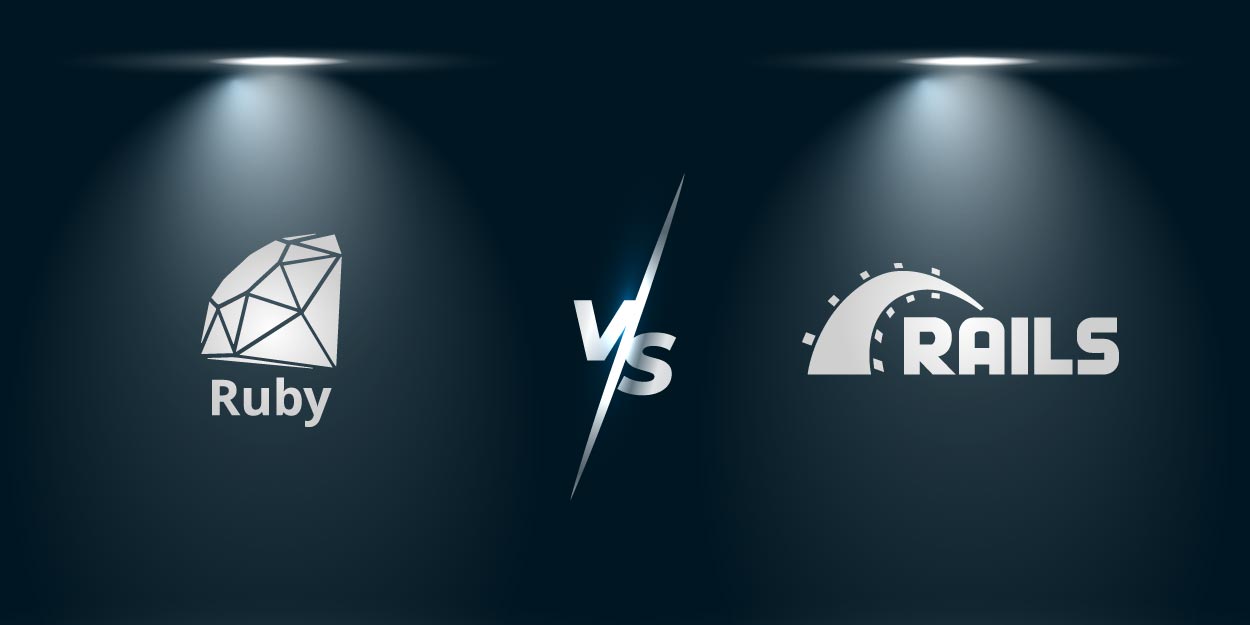Many people who hear Ruby and Ruby on Rails think that these two terms mean the same thing. While you might get the impression that the two have a lot in common, the reality is quite different. Thanks to this guide, you will clear all your doubts about this topic. Also, you will gain valuable knowledge, which may be useful when you choose the right tools for software development.
Table of Contents:
3.1. Programming language vs web development framework.
3.3. Development speed and script maintenance/
3.4. Flexibility of architecture.
What is Ruby?
Ruby is an open source and scripting software language created in 1995 by Yukihiro Matsumoto. Written in C language, allows support on multiple platforms. Simplicity of use was the main goal when creating Ruby. It is popular among developers because it enables quick creation of online applications. Among the benefits of using Ruby are:
- dynamics, which makes the software language like standard speech
- ease of maintenance and scalability
- scripting, which makes it possible to quickly create online applications
- free open-source, supported by developers from all over the world
- extra libraries to enhance its capabilities.
Ruby's advantage over many programming languages is its ease of use and intuitiveness. Thanks to that, despite the passage of years, it is still used in everyday work.
What is Ruby on Rails?
Although Ruby on Rails has a similar name to Ruby, it could not exist without this language. RoR is an open-source development tool written in Ruby and released in 2005. It is not a scripting language. Ruby on Rails is mainly used as a platform for creating web applications which uses a Model View Controller (MVC) architecture. The role of RoR is to create server-side scripts as well as web applications. The reasons for using the platform are:
- constant development of applications
- the ability to create HTML code in scripts
- good connection with databases.
Ruby on Rails makes the process of creating websites easier. Thanks to this solution, programmers do not have to write the same lines of code over and over again. It is enough to use default conventions over configuration files to streamline the existing coding process.

Ruby vs Ruby on Rails
After learning what Ruby and Ruby on Rails are, it will be easier to understand their differences. Here are some categories that differentiate the two tools. Let's take a closer look at them.
Programming language vs web development framework
Ruby is a general-purpose programming language. Like any language, it has its own syntax and specific rules. Ruby's mission is to tell the computer what to do and how to do it. It is a different case with Ruby on Rails, because it's not a programming language but a web framework. RoR uses scripts created by programmers, but it doesn't have its own unique language. Being a web application framework, Ruby on Rails aims to increase Ruby's capabilities as a programming language.
Project use
There are various types of projects that use these two tools. But, it is worth realising that it is not possible to use Ruby on Rails without Ruby. Sometimes it's more beneficial to use RoR instead of Ruby. Ruby on Rails can streamline the code and speed up the development process for web applications. The performance of RoR makes it a choice for Minimum Viable Product (MVP) development. The advantage of Ruby is visible when developing desktop applications. Due to its server-side scripting, Ruby on Rails cannot do this because it primarily runs on a web server.
Development speed and script maintenance
As I mentioned, the purpose of Ruby was to be an intuitive and simple scripting language. While working in Ruby is fast, working in Ruby on Rails is even faster. Ruby on Rails was built on the principle of convention over configuration. Default conventions mean that developers have more time to create the core parts of web apps. As a result, they can use custom configurations. When listing the advantages, keep in mind that RoR's job is to make Ruby even simpler than it is. Ruby on Rails eliminates large amounts of repetitive code and declutters the script. This makes its scripts easier compared to Ruby scripts.
Flexibility of architecture
One of the key features of both Ruby and Ruby on Rails is flexibility. All of this is thanks to the fact that both tools are open-source. As a result, developers can use HTML, Java, CSS and XML code when doing their work. For those using Ruby alone, this option is not available. This confirms another difference that has an impact during the app development process.
Summary
The two tools, as you can see, are closely related. If it weren't for Ruby, Ruby on Rails probably wouldn't exist. That's why RoR is a useful complement to Ruby that expands the possibilities. The success of both solutions is the number of businesses that use applications developed on top of them. As the years go by, questions such as "Is Ruby on Rails dead?" arise. But, the answer for many people can be surprising. Both Ruby and Ruby on Rails are an important part of creating and developing modern applications. Now, when you know what is the difference between Ruby and Ruby on Rails, you can make the right decisions about starting an app project.


%20(1).jpg)



